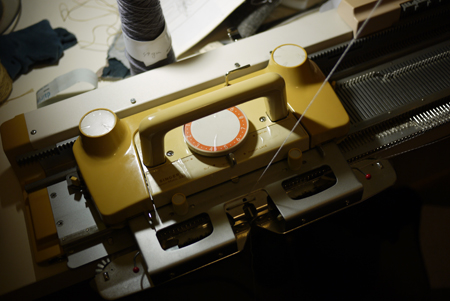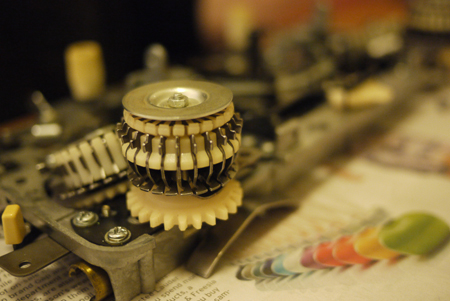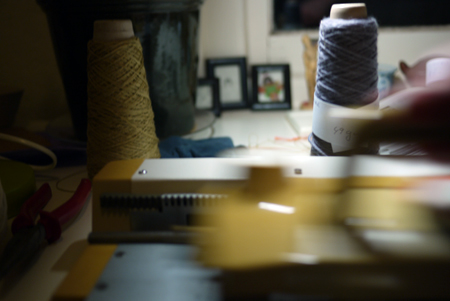And now, for those who want/need it, how to clean the drum units on a Singer 323…
All the following details relate to a Singer 323, obviously things differ from model to model so use caution and common sense.
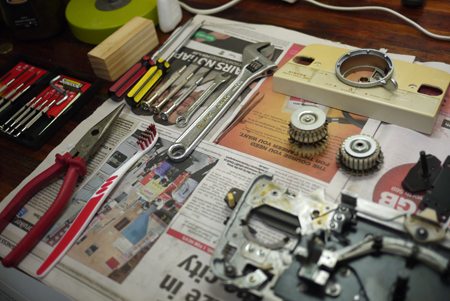
THINGS YOU WILL NEED:
- A couple of different-sized screwdrivers (medium – small ones – I had one of those sets of small ones, plus a regular-sized one). A magnetized screwdriver helps to ‘pick up’ little screws when you’re taking them out of little places, without them getting lost deeper in the machine. We magnetized a regular screwdriver by running a fridge magnet over the tip a few times.
- Denatured alcohol, for cleaning (available at the hardware shop)
- Lubricant – I used Inox-MX3. You could also use gun oil (?). Don’t use WD40, apparently it gums up over time.
- Pen, paper and double-sided sticky tape. For sticking screws on, and making notes about where they came from.
- An old toothbrush, for cleaning
- A hacksaw, to saw a new groove in a stripped screwhead (this was frustrating, I hope it doesn’t happen to you).
- Rags / newspaper
- A jar to part-fill with denatured alcohol to soak parts in
- You probably won’t need the wrench and extra screwdriver you see in that photo above.
Ready? …
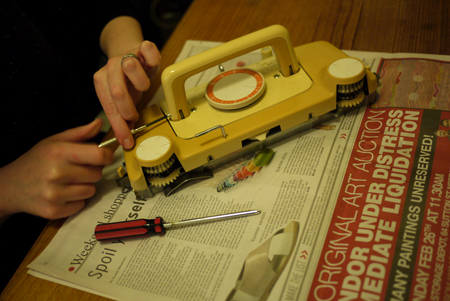
REMOVE CARRIAGE COVER
This video nicely shows how to take the plastic cover off the carriage – it’s shown on a different model from mine so a couple of things are in different places, but with common sense it wasn’t too hard to figure out.
Main differences:
- Mine had more screws to remove that attached the plastic cover to the carriage bed (near where handles attach, and at back of bed)
- I had to turn the tension dial the opposite way to in the video – to two clicks past 0
- You don’t need to unscrew the screws that you see “through” the holes where the handles connect – they’re part of the deeper workings, not the cover.
- To get the plastic cover off, I had to squeeze the front corners inwards (towards each other) to unslot a little plastic hook on the inside
- My cam lever had been stuck so took a bit of fiddling to get the cam lever ring out (make sure lever is clicked over to knit-in position)
Once that was off, R and I had a good poke around and decided that yes, it was the secondary drum that was stuck (some people call it the sub-drum).
To remove the primary and secondary drums, we mostly followed the instructions in this helpful post by Ravelry user Elizabethruns, in the Aussie Machine Knitters discussion board.
Again, it took a bit more commonsense-figuring and examining to figure out, but basically is as follows..
REMOVE DRUM PLATE FROM CARRIAGE BED
The primary and secondary drums are both attached to a single metal plate (let’s call it the “drum plate”), which is attached to the carriage bed by four screws. Remove the screws, remove the whole plate with both drums attached.
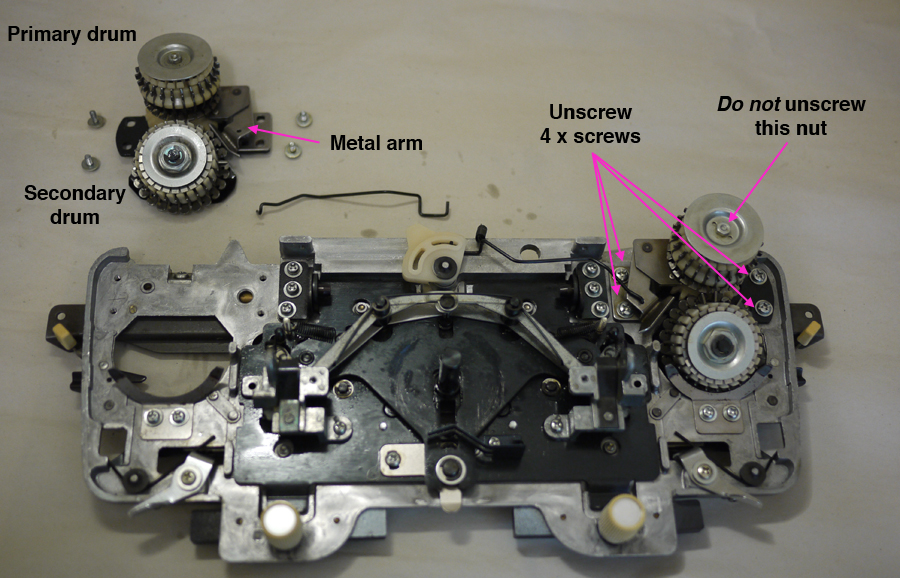
There’s a metal “arm” which sits in with the main drum, this arm is attached to the drum plate by a single screw. Remove the screw & set aside the arm.
(NB: Elizbethruns on Ravelry warns not to let the drum units themselves come apart as they have lots of little components you don’t want to put back together (or lose). It looks like you would have to deliberately unscrew the nuts on each drum to make them come apart, so don’t do that…)
REMOVE DRUMS FROM SPINDLES
There’s a clip on the top of secondary drum, which you’ll need to remove. It’s sort of C-shaped – use a screwdriver stuck into the curve of the C to lever it off. After taking the clip off, take off the metal washer underneath and set aside.
You should now be able to pull off the main drum and the secondary drum. It may take a bit of leverage – on mine the secondary drum was really stuck, with a bit of wiggling and pulling it came off. There’s a metal washer at the bottom of the secondary drum, remove it and set aside.
This is where the double-sided sticky tape comes in handy…

CLEAN & LUBRICATE
Use denatured alcohol to clean everything – the drum spindles (and where the spindle goes inside the drums), and around the cam lever, any other gunky bits on the carriage bed. Soak metal parts in alcohol for 30 mins to remove gunk. (NB: some people say to remove plastic parts before soaking in alcohol? Couldn’t remove plastic parts from these drum units without going mad (see note above) so just poured a bit of alcohol in and let it sit for a minute or two. )
Lubricate with Inox-MX3 or gun oil. Don’t use WD40, apparently it works short term but can gunk up and damage your machine long-term. Most on the Ravelry Aussie Machine Knitters group recommend Inox.
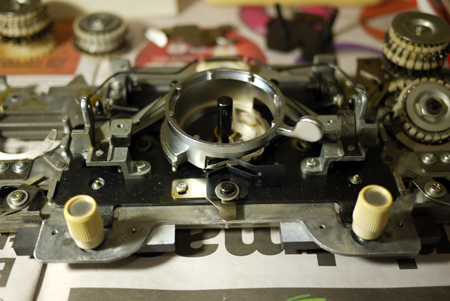
PUT IT BACK TOGETHER
Elizabethruns says: “When you put it back together, it doesn’t matter how the drums align, there is no secret there.”
Replace the outer plastic cover – squeeze the front corners of the outer plastic cover to get those little plastic hooks into the bit on the metal frame where they go.
NB: Don’t screw the cover in now – wait until a few steps on when the cam lever and tension dial are in place & turning properly before you screw the plastic down, it took me a couple of goes to get them in right.
Before you replace the inner plastic cover, make sure that the black triangular-ish plate that sits kind of “on top” in the middle of the carriage (see pic below) is pushed as far forward as it can go. It has to be forward to get the tension dial on later (guess how I know that).
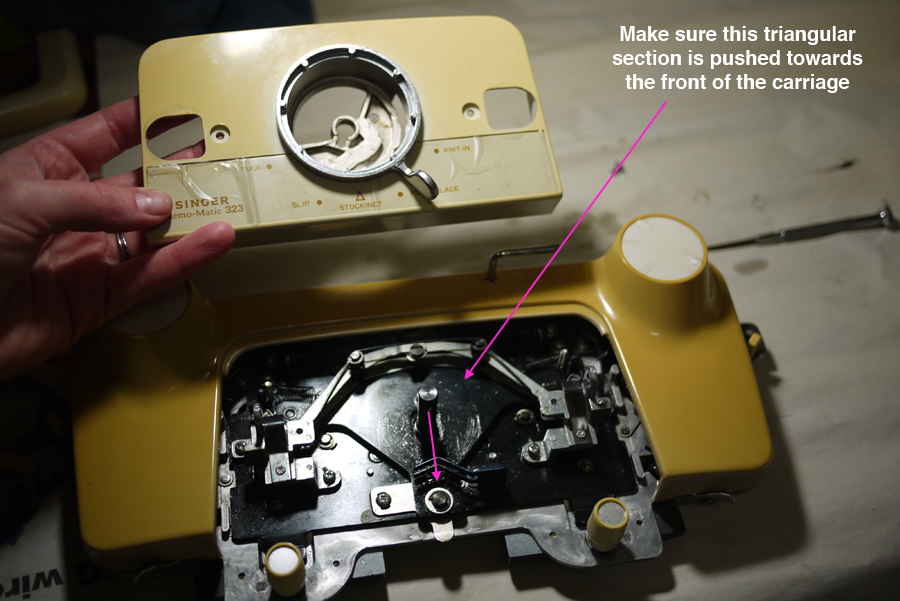
Replace inner cover and cam lever ring:
- Fit the cam lever into the plastic cover – there’s a metal bit that tucks under the plastic cover.
- Align cam lever ring with its spindle – there’s only one way it will go on because of the notch in the spindle and corresponding gap in middle of cam lever ring – i.e. with lever in “knit-in” position. (I took the above picture before I’d figured that out.)
- At the front of where the cam lever sits, there’s a black metal lever-ish spring thing, with two prongs. The BOTTOM prong should sit in the little ‘V’ grooves around the cam lever ring – the picture below shows what it would look like without the inner plastic cover. Make sure the cam ring gets past the top prong and all the way down. Make sure the lever can move around to all the positions (from ‘tuck’ through to ‘knit-in’).
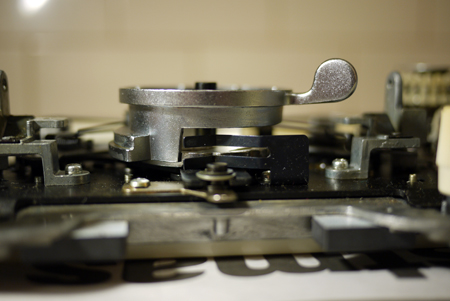
Replace tension dial – the tension dial sits inside the cam lever ring. Align the dial with the space between 0 and 10 to the front (the same way you took it off – it will only work one way), and push it in. The TOP black prong inside the carriage at the front sits in the grooves around the bottom of the tension dial. Make sure the tension dial turns easily and ‘clicks’ into each tension setting.
Screw the plastic cover back on, and screw the handle back in.
DONE! Now you have a clean, happy carriage.
